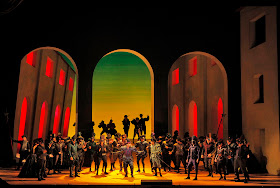Sept. 11, 2012
Having a production design back for a fourth go-around is no
problem when it’s Michael Yeargan’s 1997 chiaroscuro set, an urban nightscape
of stark angles and colors drawn from the work of Giorgio de Chirico, but also
evocative (to American eyes) of Edward Hopper. The effect is a world bent on darkness
and chaos, which certainly fits Rigoletto. Constance Hoffman, meanwhile,
contributes supremely ornate medieval Italian fashions that represent the Mantua
court’s excesses of power.
Repeated exposure to the opera reveals a creation
ridiculously rich in melody – with a cast, in this case, fully equipped to take
advantage. Italian tenor Francesco Demuro issued a plea for understanding in
consideration of his head cold, and then proceeded to deliver a perfect Duke.
His tone casts an even balance between lirico and spinto, capturing both sides
of the macho but over-romantic rake. Demuro excelled – as a lady-killer should
– in his duets, notably the artfully accomplished double cadenza at the end of
the Duke’s song to Gilda, “È il sol dell’anima,” and the turns at the ends of
his phrases in his playful seduction of Maddalena, “Un dì se ben rammentomi,”
at the beginning of the famed third-act quartet.
Serbian baritone Zeljko Lucic plays Rigoletto with admirable
attention to line, pulling his phrases here and there to match the moment’s
emotions. This was most evident in his recollection of Gilda’s late mother,
“Deh non parlare al misero,” and in his later plea to the courtiers,
“Cortigiani, vil razza dannata.” Polish soprano Aleksandra Kurzak began the
evening sounding a bit brittle, but went on to reveal extraordinary skills,
including an otherwordly trill at the closing of “Caro nome” and the ghostly
pianissimo high notes at the end of the death scene. Her second-act confession
to her father was simply, emotionally, ravishing. Kurzak’s girlish features
lent to the image of an innocent who must be guarded, and her small stature
matched Demuro’s, making for an unusually believable body-bag.
Italian bass Andrea Silvestrelli presents a Sparafucile of
intimidating size, both physically and vocally. The final note of his
introduction set off seismographs in Berkeley.
Director Harry Silverstein took an approach that was mostly
conservative, using the courtiers as static tableux for the principals, but did
choose his spots for comedy – such as a long-needed poke at the overdone addios
between Gilda and Gualtier Malde in Act 1. The maid, Giovanna (mezzo Renée
Rapier), made several attempts to wrestle the disguised Duke out the back door,
finally yanking off his jacket. Another opportunity – a blinded Rigoletto
holding the ladder for his own daughter’s abduction – went sadly unexploited.
Yeargan’s set has some amusing funhouse qualities.
Rigoletto’s apartment slides onstage even as Rigoletto enters, and
Sparafucile’s inn sports a wall of striking red blinds. Nicola Luisotti’s
conducting was brisk and incredibly sharp. Luisotti is an animated figure, and
a pleasure to watch. At one point, working the dynamics of the men’s chorus, he
held up a hand as if he were holding a wineglass, then made the glass smaller
and smaller as the chorus got quieter.
Through Sept. 30, War Memorial Opera House, 301 Van Ness
Avenue. Alternating casts. $22-$340. 415/864-3330, www.sfopera.com.
Images: Aleksandra Kurzak (Gilda). Željko Lučić (Rigoletto). Photos by Cory Weaver.
The opera will present a free simulcast of the production on the high-def scoreboard at AT&T Park, 8 p.m., Sept. 15. www.sfopera.com for details.
Images: Aleksandra Kurzak (Gilda). Željko Lučić (Rigoletto). Photos by Cory Weaver.
The opera will present a free simulcast of the production on the high-def scoreboard at AT&T Park, 8 p.m., Sept. 15. www.sfopera.com for details.
Michael J. Vaughn is a 25-year opera critic and the author
of 13 novels, including Operaville, available at amazon.com. His poem, “How to
Sing” will appear in the fall 2012 issue of the literary magazine Confrontation
(Long Island University, Brookville NY).




No comments:
Post a Comment